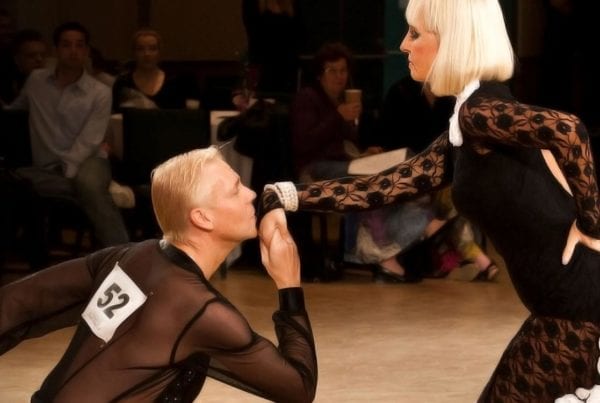Originating in the early 20th Century, the American Smooth Foxtrot is a beautiful, elegant dance characterized by long, flowing movements and expressive use of the arms. It evolved from a simpler version of Foxtrot that’s now referred to as Social Foxtrot, and developed through the expressive choreography of the popular musical motion pictures like those starring Fred Astaire and Ginger Rogers.
Every dance has unique and beautiful characteristics. While I love all of them, there are numerous things I particularly like about the Smooth Foxtrot. These same things are why I recommend this dance for every social dancer.
Dance in general improves cardiovascular health. Dancing is a great way to get your heart pumping. The Foxtrot, like many dances, can utilize energy and movements that help increase your heart rate and blood flow.
There is far less technical precision required for the Foxtrot than there is for its more sophisticated sister dance, the International-style Slow Foxtrot. They are different dances. While Slow Foxtrot is a challenging dance that can be frustrating for beginners, the Smooth Foxtrot is quite the opposite. The basic steps are very easy to learn, so you can begin to be quite proficient in a fraction of the time that it takes to master the Slow Foxtrot. The footwork is similar to Quickstep, but slower, and like other dances helps to improve your coordination and balance.
There’s a lot of opportunity to develop your skill with the use of arms. As you progress, you’ll find yourself working on creating volume through stretching and reaching, which increases your flexibility and range of motion.
The Foxtrot is a smooth and elegant dance that, perhaps because it’s so easy to learn, is known for reducing stress more than most other dances. Its slow, flowing movements can help you release tension and feel more relaxed. One of the benefits of the Foxtrot is that it encourages you to let go of your inhibitions and embrace your playful side. As you move across the dance floor, you’ll feel a sense of joy and freedom that can be infectious. It also helps to increase your confidence and self-esteem as a dancer, because you’ll find yourself getting up to speed quickly in comparison to most other dances.
One of the primary superpowers of the Foxtrot is talking and dancing. This type of multi-tasking is much more challenging in other dances, so the Foxtrot is the way to go to make your dancing more social. Because many of the figures are so basic, it’s easy to chat with your partner without the typical problem of trying to think of your step patterns while dancing.
One of the best things about the Foxtrot is its versatility. Unlike other dances, it can fit with a wide variety of musical styles and musical tempi. With the Foxtrot, there will never be another wedding reception, reunion, office party, or dinner dance where you won’t be able to get up and dance. Foxtrot is as adaptable as it is easy to do, so it scores big in the practical department.
Another thing that’s so great about this dance is that because so many of the figures start exactly the same way, it’s really easy to handle floorcraft. With most other dances, a large percentage of figures are limited to what figure you just did, which determines which foot you start on. Not so with most of the Foxtrot. It’s very easy to put together a routine as you’re dancing without really having to think about it much, because the figures begin and end so consistently.
You’ll also find that the basic figures are surprisingly sophisticated. In other dances, the Bronze level can seem somewhat restrictive. This causes people to want to move onto additional levels before they are ready, stunting their progress because they don’t give themselves time to develop a proper foundation. With the Foxtrot, even the bronze-level figures are interesting and can be developed to beautiful sophistication. For example, just changing your hand hold can give many of the figures a completely different and more dramatic look.
One of the coolest, and unexpected, benefits of Smooth Foxtrot is its similarity to the Tango and the Quickstep. And even other dances. With just a slight change, you’ll see that these other dances are closer than you might think, and therefore much easier to learn. The Chasse in Quickstep, for example, is pretty much identical to the Zig Zag in Foxtrot, just quicker! The Box step in Foxtrot is identical to the Box in Waltz.
The Foxtrot has remained relevant for a century because of it’s ease of use and practical application to any dance environment. So if you’re sitting on the fence about learning this dance, give it a try. You’ll be glad you did.
Take a look at these great examples of Foxtrot from Dancing With the Stars:














